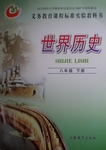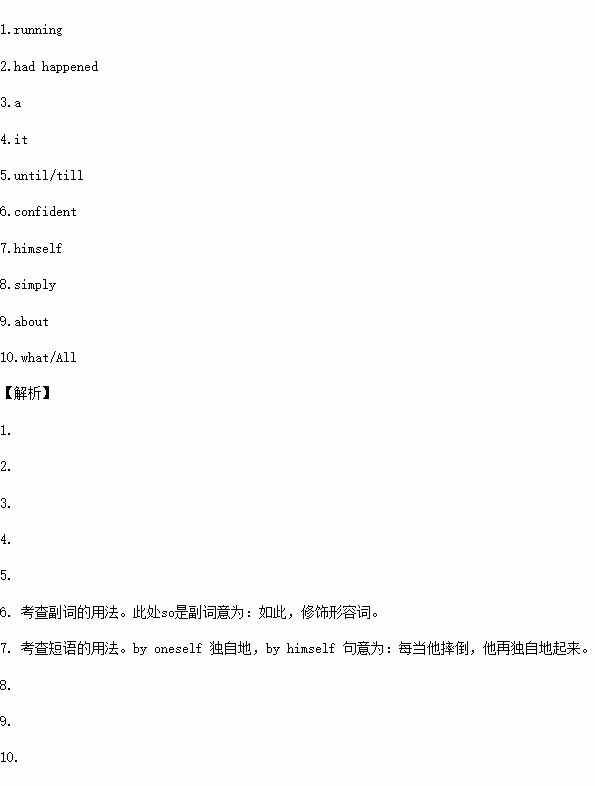题目内容
One afternoon many years ago, I sat down on a chair in a park and watched a little boy, around 2 years old, 1.(run) freely on the grass as his mother watched from a short distance.The boy would fall to the grass, get up, and without looking back at his mother, run as fast as he could as if nothing 2.( happen).
When kids fall down, they don't think of the fall as3.failure. Instead, they consider 4.as a learning experience.They try and try again5. they succeed.
I was also touched by the way he ran. With each attempt, he looked so 6.(confidence) and natural.He only wanted to run freely and to do it as well as he could.He was just being a child--- being himself completely at the moment.He never gave up.Each time he fell, he got up again by7., as if he knew that falling down was8.(simple) a part of life.
He was not looking for others' smiles, or worrying 9. whether someone was watching or not.  10. he wanted was to run and to feel the experience of running fully and freely.I learned a lot from the experience.
10. he wanted was to run and to feel the experience of running fully and freely.I learned a lot from the experience.
 探究与巩固河南科学技术出版社系列答案
探究与巩固河南科学技术出版社系列答案

 e,收到一封署名为Worried的求助信。信中该同学想你诉说了自己的困扰:近日压力大,容易失眠,使正常的学习和生活受到了影响。请用英文给该同学回一封信。
e,收到一封署名为Worried的求助信。信中该同学想你诉说了自己的困扰:近日压力大,容易失眠,使正常的学习和生活受到了影响。请用英文给该同学回一封信。 would be a good time to let my teenage daughter Holly practice her driving, so I sent her to the store in my truck. At dinner my son talked about how much he liked my truck. I enjoyed having it, but I said: “Guy, my heart is not set on that truck. I like it but it is just metal and won't last forever. Never set your heart on anything that won't last.” After hearing the loud noise, the whole family ran outside. My son shouted: “Dad! Dad, Holly crashed your truck.”
would be a good time to let my teenage daughter Holly practice her driving, so I sent her to the store in my truck. At dinner my son talked about how much he liked my truck. I enjoyed having it, but I said: “Guy, my heart is not set on that truck. I like it but it is just metal and won't last forever. Never set your heart on anything that won't last.” After hearing the loud noise, the whole family ran outside. My son shouted: “Dad! Dad, Holly crashed your truck.” till felt the pain of the night. It was a deep wound on her soul. I remember how sad Holly was on the night she crashed our truck, and how I comforted her. One day, when Holly thinks back on her life, I want her to know that I love her a thousand times more than any piece of property.
till felt the pain of the night. It was a deep wound on her soul. I remember how sad Holly was on the night she crashed our truck, and how I comforted her. One day, when Holly thinks back on her life, I want her to know that I love her a thousand times more than any piece of property. ford solid oak stairways, although they were once fairly common in older homes. Nor can they afford the high labor cost of employing a carpenter to build the stairway. Yet if someone can pay the high cost, there are still plenty of carpenters around able to make those stairways. And not only would these carpenters know how to build them, they would probably do a better job than carpenters of old.
ford solid oak stairways, although they were once fairly common in older homes. Nor can they afford the high labor cost of employing a carpenter to build the stairway. Yet if someone can pay the high cost, there are still plenty of carpenters around able to make those stairways. And not only would these carpenters know how to build them, they would probably do a better job than carpenters of old. t could create a stronger equal partnership or it could create new insecurities.
t could create a stronger equal partnership or it could create new insecurities. stem, with its aggressive way of doing business and its insistence(坚持,强调) on money and social status as indicators of worth. In Willy Loman, the hero of the play, we see a man who has got into trouble with this system. Willy is "burnt out" and in the cruel world of business there is no room for sentiment(感伤): if he can't do the work, then he is no good to his employer, the Wagner Company, and he must go. Willy is painfully aware of this, and at a loss as to what to do with his lack of success. He refuses to face the fact that he has failed and kills himself in the end.
stem, with its aggressive way of doing business and its insistence(坚持,强调) on money and social status as indicators of worth. In Willy Loman, the hero of the play, we see a man who has got into trouble with this system. Willy is "burnt out" and in the cruel world of business there is no room for sentiment(感伤): if he can't do the work, then he is no good to his employer, the Wagner Company, and he must go. Willy is painfully aware of this, and at a loss as to what to do with his lack of success. He refuses to face the fact that he has failed and kills himself in the end.